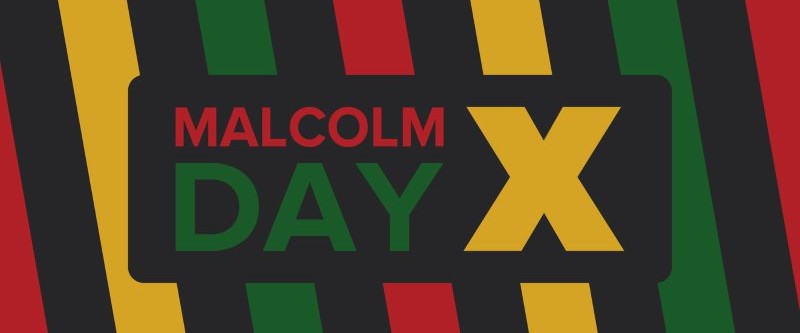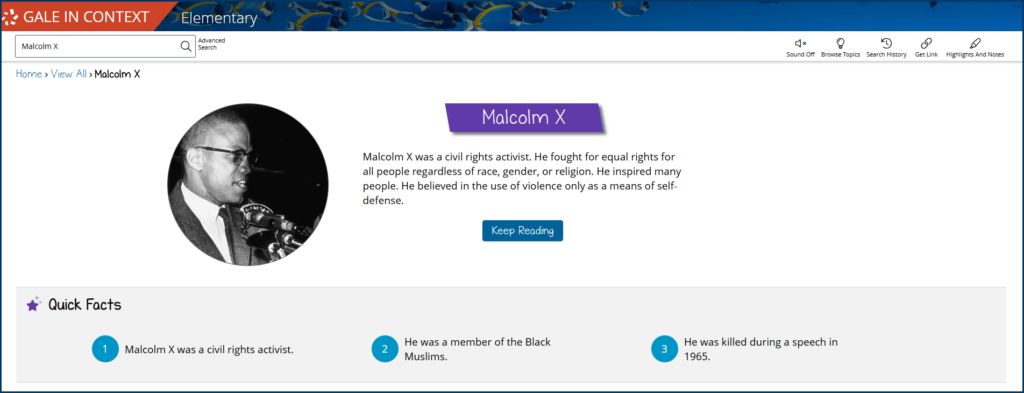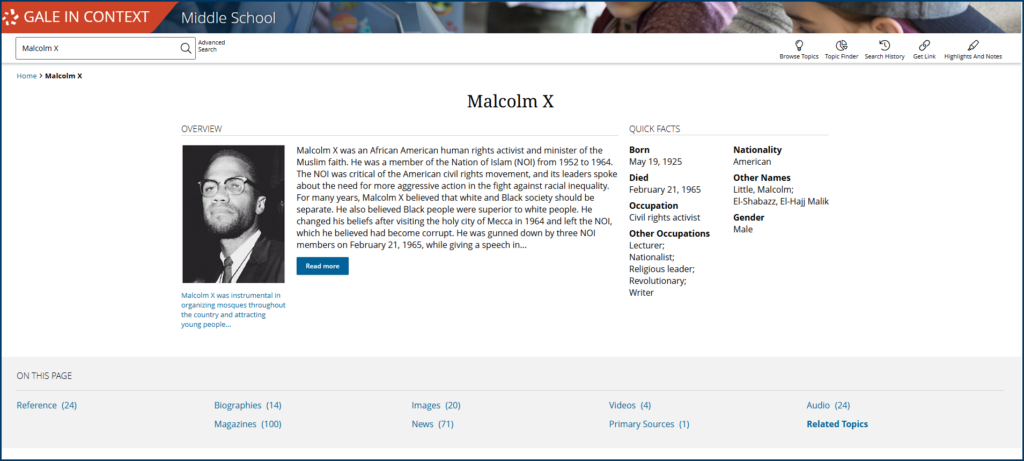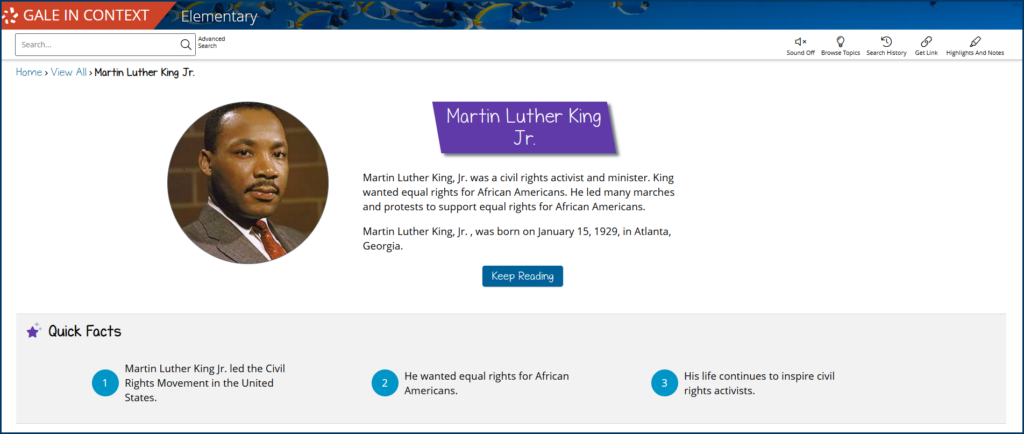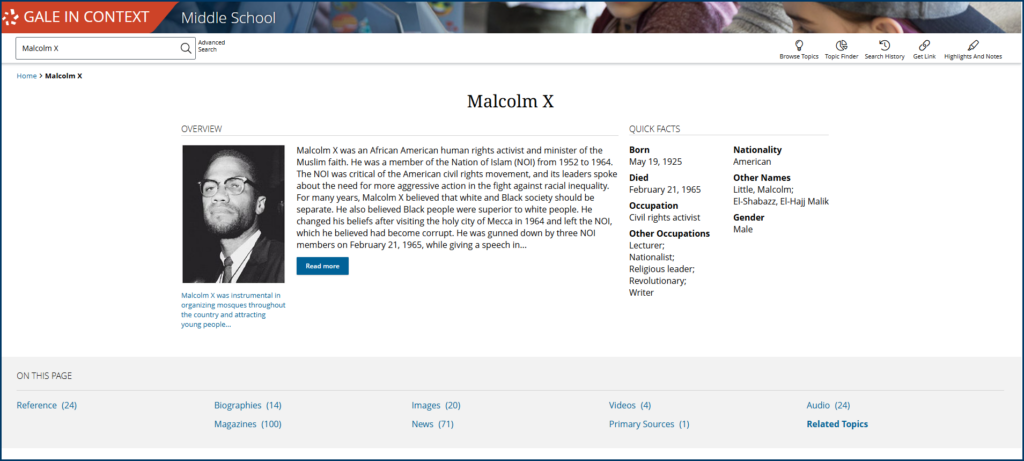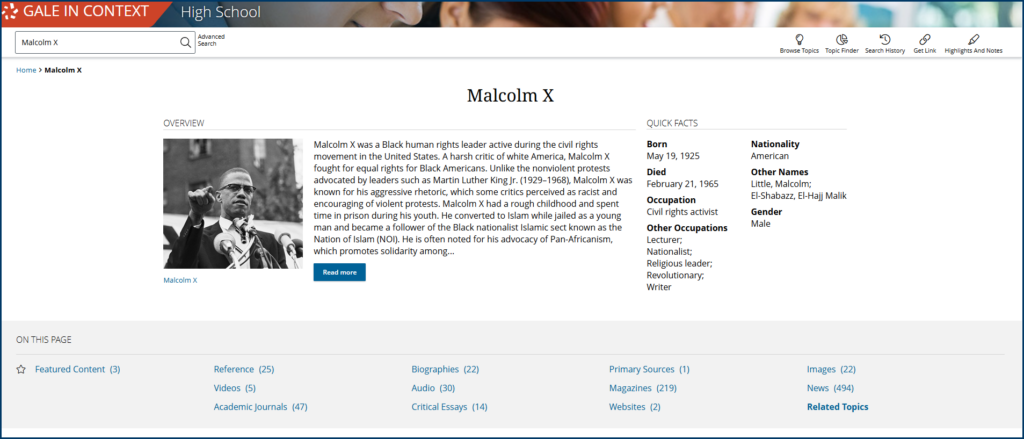| By Gale Staff |
Malcolm X was born in 1925, at a time when the promises of Reconstruction had given way to the systemic oppression of Jim Crow. By the time of his assassination in 1965, Malcolm had become one of the most formidable voices of the Civil Rights Movement, equally revered and feared for his unflinching critiques of white supremacy and his calls for black self-determination.
For educators, presenting Malcolm’s life requires thoughtful resources that encourage inquiry and critical thinking. Gale In Context: Elementary, Middle, and High School offer a range of materials—from primary sources and biographies to historical analysis and multimedia content—that can spark discussions, inspire research projects, and help students connect Malcolm X’s activism to the broader Civil Rights Movement.
Malcolm X’s Early Years
Before Malcolm X, there was Malcolm Little: a boy who loved books, did well in school, and had big dreams for his future. Growing up during the Great Depression, the world didn’t see that potential.
His father’s activism made their family a target of racial violence, including the arson of their home. A few years later, his father died under suspicious circumstances. Authorities refused to investigate.
With no justice and no financial support, his mother was left to raise their family alone. Overwhelmed, she was institutionalized, and Malcolm and his siblings were separated into different foster homes.
Despite these challenges, Malcolm excelled academically and aspired to become an attorney. When he shared that dream with a teacher, the man told Malcolm to aim lower—that maybe he should consider becoming a carpenter. That moment stayed with him for the rest of his life.
Malcolm X’s Reeducation
Malcolm Little’s formal education ended in eighth grade. He drifted between low-paying jobs, eventually turning to drug dealing and gambling to support himself. That came to an end in 1946 when he was sentenced to 10 years in prison for burglary.
Prison turned into an unexpected opportunity for Malcolm to engage with new ideological perspectives, most notably the teachings of the Nation of Islam (NOI). Led by Elijah Muhammad, the NOI used the tenets of black nationalism to reframe racism not as individual prejudice, but as a structural system designed to uphold white supremacy.
Frustrated by his struggle to express himself in writing, Malcolm also embarked on an exhaustive self-education process. He dedicated himself to copying the dictionary page-by-page and reading voraciously about history, philosophy, and law.
When Little emerged from prison in 1952, it was as Malcolm X. He rejected his birth name as a symbol of the loss of his stolen ancestral identity, and Malcolm X as reflective of his right to define himself.
He quickly became the voice of the NOI—and one of the most polarizing figures in America. Unlike the mainstream Civil Rights Movement, the NOI was a separatist organization. They argued that true liberation required autonomy outside the American system.
Shifting Ideologies and New Enemies
Malcolm X’s beliefs about the Civil Rights Movement began to change as he became disillusioned with Elijah Muhammad and NOI leadership.
In 1964, he severed ties with the organization and set out to see the world beyond the United States. During a pilgrimage to Mecca, he witnessed Muslims united by faith rather than race, which challenged his previous belief that racial divisions were absolute.
These new ideas caused Malcolm X to make enemies on multiple fronts.
The U.S. government, wary of his calls for black self-defense, had opened an FBI file on him in March 1953 and conducted surveillance. The CIA also got involved as his influence expanded beyond national borders. They feared that if black Americans aligned with newly independent African nations, it could challenge American power on the world stage during the volatile years of the Cold War.
At the same time, Malcolm was exposing corruption within the NOI, openly challenging Elijah Muhammad’s authority in a way the organization couldn’t ignore.
These forces converged on February 21, 1965, when Malcolm X was assassinated while speaking at the Audubon Ballroom in Harlem. Three members of the NOI were convicted of the crime.
In 2021, two of the men convicted of his murder were exonerated, reigniting questions about government involvement and the true extent of the conspiracy against Malcolm. His assassination was meant to silence him, but his influence never faded. His story remains unfinished, his ideas still debated, his legacy still evolving.
For Elementary Classrooms
Gale In Context: Elementary provides unbiased historical accounts and modern perspectives, while ensuring that content is developmentally accessible and topically appropriate for grades K-5. Students can access topic pages for Malcolm X, Martin Luther King, Jr., and other Civil Rights leaders. Resources include articles, magazines, news coverage, biographies, and historical images—all in one place.
Similar Goals, Different Paths: Comparing Martin Luther King, Jr. and Malcolm X
King and Malcolm are often seen as opposing figures because of their different backgrounds and approaches. While King was framed as the acceptable face of the Civil Rights Movement, Malcolm was cast as violent and reckless.
Yet both wanted the same thing: fairness and equality. By the time of his assassination, Malcolm’s relationship with King was evolving. While their philosophies had been at odds, Malcolm had begun expressing support for some of King’s initiatives; King, in turn, acknowledged Malcolm’s importance to the movement.
Discussion Prompts
- Why do you think two people might want the same thing, but use different ways to get it?
- How might someone’s childhood affect their approach to problem-solving?
- Even though King and Malcolm had different backgrounds and methods, they both cared deeply about justice. How can we work with people who have different ideas to solve problems?
For Middle School Classrooms
Malcolm’s emphasis on black autonomy often placed him at odds with other civil rights organizations. However, the activists of the Civil Rights Movement were never a monolith. Leaders and organizations employed many strategies, from waging legal challenges and nonviolent demonstrations to asserting the right to self-defense.
Gale In Context: Middle School fosters in-depth, inquiry-driven research. The platform’s multimedia resources allow students to examine the diverse strategies of civil rights leaders, prompting reflection on the motivations behind key decisions and the broader context in which they occurred.
Connecting Malcolm X to the Broader Civil Rights Movement
Split the class into small groups. Assign each an activist or organization to investigate for key beliefs, methods, achievements, criticism they received, and impact on the Civil Rights Movement.
- Influential behind-the-scenes leader who helped grow the Student Nonviolent Coordinating Committee (SNCC).
- Believed in grassroots empowerment and collective leadership that challenged hierarchical structures.
The Black Panther Party (founded in 1966)
- Formed in Oakland, California, by Huey P. Newton and Bobby Seale; promoted armed self-defense to combat police brutality.
- Combined militant rhetoric with community programs such as free breakfast for children to spotlight systemic inequalities.
Stokely Carmichael (Kwame Ture) (1941–98)
- An early SNCC leader who popularized the concept of Black Power.
- Emphasized racial pride and self-determination, reflecting the increasing assertiveness of the movement in the late 1960s.
- Sharecropper-turned-activist who co-founded the Mississippi Freedom Democratic Party.
- Emphasized voter registration and political representation, while sharing personal testimonies of injustice to nationalize the struggle against Jim Crow.
Martin Luther King Jr. (1929–68)
- Baptist minister and leader of the Southern Christian Leadership Conference who organized protests such as the Birmingham campaign and the 1963 March on Washington.
- Advocated nonviolent civil disobedience, believing that persistent moral witness would transform racist systems.
Discussion Prompts
After students share the findings from their research, hold a classroom discussion based on the following questions:
- Compare the objectives and methods of these organizations. How did they align? How did they differ?
- How did the social and political climate of the time (e.g., Jim Crow laws, racial violence, Cold War pressures) influence strategy? Were there moments when different paths intersected or conflicted?
- After his pilgrimage to Mecca, Malcolm X began to understand the possibilities for racial reconciliation. Did any other figures experience a similar evolution? What might spark such a change in philosophy or tactics?
For High School Classrooms
Historical memory is not a fixed record. Public figures’ reputations are subject to shift as societal values, media narratives, and access to information change. Activists once labeled as controversial or radical may later be appreciated for their visionary perspectives.
With its collection of hundreds of thousands of topic overviews, primary sources, biographies, and critical essays, Gale In Context: High School illustrates how historical reputations are shaped and challenged over time.
Primary sources—such as Angela Davis’s FBI wanted poster and Nat Turner’s confession—expose how authority figures seek to control narratives, while letters—including those between Benjamin Banneker and Thomas Jefferson—offer a more personal perspective. Conducting research with these resources, alongside commentary, editorials, and retrospective analyses, reveals how legacies are rewritten, who has the power to reshape them, and to what end.
How Media and Time Change Legacies: Five Black Americans with Legacies in Flux
Evaluate historical and contemporary sources to understand why certain individuals were once dismissed, censored, or even reviled—only later to be lauded as visionaries.
Harriet Tubman (1822–1913) escaped enslavement and led dozens of others to freedom via the Underground Railroad. During the Civil War, she served as a spy and scout for the Union Army.
- Then: Branded a criminal by pro-slavery forces, with bounties for her capture.
- Now: Hailed as a hero and a symbol of courage.
Paul Robeson (1898–1976) was an acclaimed singer, actor, professional football player, and civil rights activist whose low-bass baritone voice made songs like “Ol’ Man River” and “Swing Low Sweet Chariot” household names.
- Then: Blacklisted during the McCarthy era for his outspoken political beliefs, especially his advocacy for racial equality and workers’ rights.
- Now: Celebrated as a barrier-breaking social justice advocate and pioneering artist.
Muhammad Ali (1942–2016), a charismatic, outspoken heavyweight boxing champion, used his fame to challenge racial inequality and America’s participation in the Vietnam War.
- Then: Stripped of his title and labeled unpatriotic for rejecting military service.
- Now: Revered as a global sports legend and advocate for racial justice.
Jackie Robinson (1919–72) broke Major League Baseball’s color barrier in 1947 as second baseman for the Brooklyn Dodgers.
- Then: Met with insults, threats, and discrimination from within and outside his own team.
- Now: Honored as a sports hero whose jersey number (42) is retired across all MLB teams.
Discussion Prompts
- What social or political interests might shape public perceptions of figures labeled as controversial?
- Compare how figures like Malcolm X and Paul Robeson were portrayed during their lifetimes versus today. How does this compare to figures today like Colin Kaepernick, Kendrick Lamar, and Serena Williams, who have used their platforms for social advocacy?
- What factors determine whose version of history is preserved? Can you think of other individuals whose legacy has been transformed over time?
Contact your local Gale sales representative to learn more about Gale In Context’s unbiased content from diverse perspectives, and how it can equip learners of all ages with the tools to think critically.

